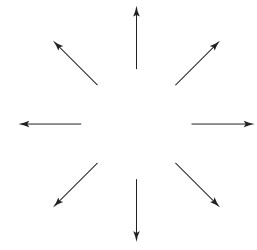Question
Use the electric field drawing below to answer the questions. A, B, and C are physical sources of charge. Points e, d, and f are points within the field.

(a) Describe the relative amount of charge and type (positive or negative) at each of locations A, B, and C . Explain your answers.
(b) Rank the relative strength of the net electric field at each of points e, d, and f . Explain your answer.
(c) By extending the existing sketch, sketch out what the field lines would look like from very far away from these charges. Assume no other charges are present.
(d) On the sketch above, draw a single, complete equipotential surface that runs through point f.
(e) How can there always be electric potential at point f and yet the electrical potential energy sometimes be zero?
(f) If a proton was placed at point f , in what direction (if any) would it experience a force? Would its change in electrical potential energy be negative or positive as it moved in response to this electrical force? Explain your reasoning.
(g) Repeat the answers to the questions in part (f) but for an electron placed at point e.
▶️Answer/Explanation
Ans:
(a) The number of field lines indicates the amount of charge. The direction of field lines indicates the type of charge:
amount of charge A (positive) > amount of charge C (positive) > amount of charge B (negative)
(b) The strength of the field is proportional to the density of the field lines:
field at e > field at f > field at d
(c) From very far away, the details of the actual charge distribution will not matter. The field will look like that of a positive point charge with the 7 unconnected field lines coming out uniformly.

(d) Equipotential lines should intersect electric field lines perpendicularly, do not have direction, and are continuous.

(e) Electric potential comes from the source charge and does not require a test charge to be present in the field. Electrical potential energy exists only if there is a test charge present within the field: EPE = qV .
(f) A proton would follow the field direction at its location, so up and to the right at point f . Positive charges go from high voltage to low voltage:
ΔV < 0, so qΔV < 0
Electrical potential energy decreases while electrical potential decreases.
(g) Electrons will experience a force in the opposite direction from the field lines, so straight toward A at point e . Negative charges go from low voltage to high voltage:
ΔV > 0, so qΔV < 0
since q is negative. Electrical potential energy decreases while electrical potential increases.
